Features - February 23, 2000
Glowing bacteria give researchers
a key to new antibiotics
Princeton scientist studies bioluminescence
By Billy Goodman '80
Rudolph the Red-nosed Reindeer has nothing on the Hawaiian bobtail squid,
Euprymna scolopes. This tiny squid-just a few inches long-lives in shallow
waters off the West Coast and Hawaii and hunts at night above sand flats.
It eats small fish and invertebrates and in turn is eaten by larger fish.
It could be especially vulnerable on bright nights, when light from the
moon and the stars could cause the squid to cast a shadow as it hunts in
knee-deep water.
No problem. E. scolopes senses the amount of light hitting its backside
as it swims and then projects light from below, effectively canceling its
shadow. How does the squid turn on its nightlight?
Enter Vibrio fischeri, a bacterium found in coastal waters all over the
world. Related to vibrios that cause cholera and other diseases, V. fischeri's
trick is to glow-bioluminesce is the jargon-when present in high cell numbers.
The squid has discovered a way to take in and nurture V. fischeri in a special
light organ and use it to its own advantage. Or, perhaps, the bacterium
has figured out a way to coax the squid to provide a nutrient-rich place
for it to live and multiply.
While the tiny squid has earned a chapter in any strange-but-true compilation
of zoology, the lowly bacterium deserves its due. Indeed, V. fischeri has
a means of "counting" how many of its pals are present and then
turning on a genetic pathway leading to the production of bioluminescence
when the population is dense. The process, called "quorum sensing,"
may provide a basis for developing new antimicrobial drugs and perhaps even
thwarting the alarming increase in bacterial resistance to mainline antibiotics.
If taking advantage of quorum sensing proves commercially valuable in
this way, then Princeton may benefit financially. One of the leaders in
pushing knowledge forward in this rapidly developing field is a newly tenured
associate professor of molecular biology, Bonnie Bassler. Bassler has been
working on quorum sensing since before coming to Princeton six years ago.
Her postdoctoral mentor at California's Agouron Institute first elucidated
the genetic pathway by which V. fischeri assessed its density and initiated
the production of light. As Bassler puts it, the bacteria "talk"
to one another.
Quorum sensing in V. fischeri involves a simple signal-and-response mechanism.
Each bacterial cell produces a small molecule called an autoinducer, which
moves freely across the cell membrane. When the bacteria are at low cell
density-such as free-living in seawater-autoinducer molecules that leave
a cell are swept away before they can enter another bacterial cell. At high
cell density, autoinducer flows from one cell into another, where it binds
to a protein. This protein-autoinducer complex then turns on specific genes-those
that make a light-producing enzyme.
If quorum sensing had been limited to V. fischeri, study of this quirky
bit of natural history would have been limited to a few microbe-obsessed
scientists-such as Bassler. Indeed, 10 years ago, it did seem as if the
ability of bacteria to respond to high density by glowing or turning on
other genes might be restricted to V. fischeri. Then things began to change.
Two light-up systems
First, quorum sensing systems very similar to that of V. fischeri were
discovered in other bacteria. Then Bassler and colleagues at the Agouron
Institute discovered that V. harveyi, a free-living marine microbe, has
two independent quorum-sensing systems to turn on its bioluminescent pathway.
Each system works in the absence of the other.
Why, Bassler wondered, did the microbe have redundant quorum-sensing
systems?
She found that V. harveyi counts itself through one system (producing
auto-inducer 1), and responds to other bacteria through the other system
(autoinducer 2). In either case, if it is in a dense population, it turns
on bioluminescence. But Bassler suspects that the two systems may permit
V. harveyi to respond differently depending on whether it is surrounded
by more of itself or by a heterogeneous population of bacteria. Her lab
is now working to determine which genes are turned on exclusively by one
system or the other.
Meanwhile, last year, the field of quorum sensing exploded, when Bassler
and her colleague Michael Surette (now at Calgary University) showed that
upwards of 30 bacteria produce an autoinducer identical, or nearly so, to
V. harveyi's autoinducer 2. The list includes numerous medically important
bacteria, such as Escherichia coli, Salmonella typhimurium, Staphylococcus
aureus, and others. These species do not make light. In the few that have
been studied so far, quorum sensing turns on genes associated with pathogenesis.
In other words, the bacteria wait until they have company before turning
on their disease-causing machinery. This makes perfect sense for them: Turn
on toxin-producing genes too quickly and the host's immune system can target
the budding infection and wipe it out; in sufficient numbers, the pathogens
may be able to overwhelm the immune system.
An antibiotic foothold
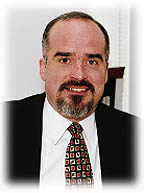 This feature provides a natural foothold for potential antibiotics.
A drug that could interfere with quorum sensing-making the bacteria "blind"
to autoinducer so they "think" they are in a dilute population
when, in fact, they are not-might delay or halt development of the disease.
With that realization, dozens of labs have started working on the problem
in the last five years. Bassler, who was content working on her glow-in-the-dark
bacteria, understood the implications. So did some of her colleagues in
the molecular biology department-especially those with experience dealing
with the biotechnology industry-and they urged her to patent her discovery.
In the fall of 1998, she disclosed her work to John Ritter (right), director
of Princeton's Office of Patents and Licensing.
This feature provides a natural foothold for potential antibiotics.
A drug that could interfere with quorum sensing-making the bacteria "blind"
to autoinducer so they "think" they are in a dilute population
when, in fact, they are not-might delay or halt development of the disease.
With that realization, dozens of labs have started working on the problem
in the last five years. Bassler, who was content working on her glow-in-the-dark
bacteria, understood the implications. So did some of her colleagues in
the molecular biology department-especially those with experience dealing
with the biotechnology industry-and they urged her to patent her discovery.
In the fall of 1998, she disclosed her work to John Ritter (right), director
of Princeton's Office of Patents and Licensing.
Princeton staff and students with inventions go to Ritter's office to
disclose them and begin the process of patenting and licensing them. As
many as 100 inventions or discoveries may be disclosed to his office in
a year, Ritter says, though the number was 60 for fiscal 1999. He makes
his own inquiries, trying to determine if the invention will generate commercial
interest. Then he tries to license the product or method to a company that
has the ability to take a basic discovery and turn it into a saleable product.
Most disclosures are not successfully licensed. "This is a 'No'
business," Ritter says. The electrical engineering department is the
biggest source of inventions at Princeton, and molecular biology is also
fertile ground. Last year, according to Ritter, the university and staff
members earned more than $1 million in license fees. No product based on
a Princeton patent was earning royalties, however, which would be the route
for a potential windfall for Princeton and the inventor.
Under Princeton's patent policy, the university and the inventors split
the first $100,000 of net income from an invention. The inventors get 40
percent of the next $400,000 and 30 percent of anything over a half-million
dollars in income.
Ritter saw potential in Bassler's work and, with publication of the research
imminent, filed a provisional patent application on her behalf in December
1998.
Protecting a discovery
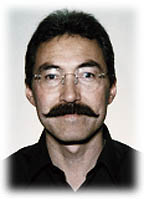 That Christmas, an old friend and former colleague, Jeff Stein (left),
called to wish Bassler happy holidays and catch up on news. The pair had
worked in neighboring labs at the Agouron Institute before Bassler left
for Princeton and Stein joined a San Diego biotechnology company. Bassler
told him about her work with autoinducer 2.
That Christmas, an old friend and former colleague, Jeff Stein (left),
called to wish Bassler happy holidays and catch up on news. The pair had
worked in neighboring labs at the Agouron Institute before Bassler left
for Princeton and Stein joined a San Diego biotechnology company. Bassler
told him about her work with autoinducer 2.
A few days later, Stein called Bassler back and asked to see the patent
application. "I was very excited," he says, "not just about
the discovery, but that she had taken the logical step of protecting that
discovery through Princeton."
Stein was so excited, in fact, that after discussions with Bassler he
incorporated Quorum Pharmaceuticals last February and toward the end of
1999 the company (now called Quorex) opened its laboratory in Southern California.
His lawyers helped finalize the patent application, which was submitted
one day before the provisional patent expired in December.
Stein says, "I think [quorum sensing] will lead to the development
of the next generation of antibiotics. Current antibiotics are becoming
less and less effective. The last major class of antibiotics was discovered
more than 20 years ago. There's an extreme need for new approaches."
A new antibiotic, if it works, may be many years off. In the meantime,
Quorex has the license to use Bassler's discovery and try to develop a proof
of principle. Bassler has no role with the company, other than serving as
a scientific adviser. She has accepted no research funds from the company,
preferring to keep her university work funded by government grants.
"I don't want the boundaries blurred between my academic pursuits
and Quorex Pharmaceuticals' pursuits," she says. Meanwhile, both the
company and the Bassler lab derive some benefits from the other. Her postdoctoral
student, Stephan Schauder, elucidated the structure of autoinducer 2. Before
he publishes the structure, the company has a head start in using it to
help construct inhibitors to the quorum-sensing pathway. Lab members develop
mutants useful in research, which Quorex can use.
Meanwhile, chemists for the company will be trying to make and test thousands
of compounds to find analogues to autoinducer 2-that is, molecules that
will bind to cell-membrane receptors for autoinducer 2 but not turn on genes
as the autoinducer would. The work is highly automated-"mind-numbing,"
Bassler calls it, "a project for a robot, not for a graduate student."
Stein guesses that within the next 12 months it will be possible to know
whether interfering with quorum sensing will provide a way to reverse or
prevent some bacterial disease.
Meanwhile, Bassler-who jokes that she is the "queen of quorum sensing"-is
getting great applications from graduate students and postdocs who want
to come train in her lab. Many are attracted by the chance to work on sexy
pathogens. Bassler, however, knows that "V. harveyi is the one that's
telling us the answers." And she is thrilled that her studies of how
V. harveyi "talks" could lead to a new field of research that
appears to have broad implications for drug design and health care.
Billy Goodman is a freelance writer living in Montclair, New Jersey.
Princeton's biomedical developments
Without a medical school, Princeton is not among the leaders in transferring
biomedical technology to industry. The $1.2 million in university-wide licensing
fees last fiscal year pales by comparison with Harvard's medical school,
which brought in more than $11 million. Part of the reason is that no products
derived from Princeton-patented inventions were in the market and earning
royalties. A possible anticancer drug based on the work of a Princeton professor
is undergoing clinical trials, however, and could be both medically important
and financially lucrative if successful.
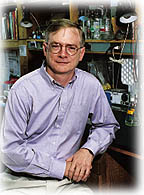 Many faculty and staff members in the Department of Molecular Biology
have ties to biotechnology and pharmaceutical companies. A few have licensed
their discoveries to industry. Elkins Professor Thomas Shenk (right), chairman
of the department, serves on several scientific advisory boards and is on
the board of directors of Novalon, a drug discovery firm whose CEO is one
of his former postdocs. Professor Jim Broach is director of research for
Cadus Pharmaceutical Corporation, which he helped found in 1992.
Many faculty and staff members in the Department of Molecular Biology
have ties to biotechnology and pharmaceutical companies. A few have licensed
their discoveries to industry. Elkins Professor Thomas Shenk (right), chairman
of the department, serves on several scientific advisory boards and is on
the board of directors of Novalon, a drug discovery firm whose CEO is one
of his former postdocs. Professor Jim Broach is director of research for
Cadus Pharmaceutical Corporation, which he helped found in 1992.
Associate Professor Ihor Lemischka, whose research involves special blood-forming
cells called stem cells, has been involved for many years with ImClone Systems,
a New York biopharmaceutical firm.
Shenk, Broach, and Lemischka all stress that the research agenda in their
Princeton labs is not influenced by their ties to industry. "Research
at a university, where postdocs and graduate students are being trained,
should focus on issues of basic biology that are of fundamental importance
to our understanding of how biological systems function," says Shenk.
Nevertheless, not everyone in the department shares the view that consulting
with or advising companies is a neutral activity. Immunologist Martin Weigert-who
has shared in some patents recently-feels "almost an abhorrence"
to be involved in anything commercial. "This is a teaching university,"
he says, "and the combination of doing good research and teaching effectively
is more than a full-time job."
Weigert's work has implications for autoimmune diseases, such as rheumatoid
arthritis, and he hopes it will contribute to cures and prevention. But
when companies ask him to consult for them, he just says no.
For lucky alumni, biotech investments
pay big dividends
Gamblers bank on life-science breakthroughs
By Marvin Zim '57
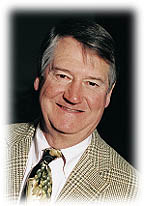
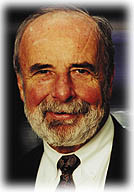 The meeting that took place in late 1980 between Jim
Blair '61 (left) and George Rathmann *51 (pic at right) turned out to be
the beginning of something very big. Rathmann, who had previously headed
Abbott Labs' diagnostic research and development division, was seeking first-round
financing that would allow his newly formed company to develop proteins
that could stimulate the growth of red blood cells. Blair's company, a New
York-based affiliate of the Rothschilds, was seeking promising investments
in the health care field.
The meeting that took place in late 1980 between Jim
Blair '61 (left) and George Rathmann *51 (pic at right) turned out to be
the beginning of something very big. Rathmann, who had previously headed
Abbott Labs' diagnostic research and development division, was seeking first-round
financing that would allow his newly formed company to develop proteins
that could stimulate the growth of red blood cells. Blair's company, a New
York-based affiliate of the Rothschilds, was seeking promising investments
in the health care field.
"Rathmann was looking for a lead investor," Blair recalls,
"and we were excited by the science." After checking out the technical
concepts and talking with the president of Abbott Labs about Rathmann's
management skills, Blair's firm invested $3 million in the company. Abbott
Labs and several other venture capital companies came up with $15 million,
which gave Applied Molecular Genetics startup financing of $18 million.
The company, now known as Amgen, is generally recognized as the most successful
biotech company in the world. Amgen's lead products-Epogen to stimulate
red blood cell growth, and Neupogen to stimulate white blood cell growth-are
used to treat cancer patients undergoing radiation and chemotherapy, and
others who are suffering from kidney failure.
By the end of 1999, the annual sales of Amgen's two leading products
approached $3 billion. Net income topped $1 billion, and Amgen's market
capitalization was a hefty $55 billion. Blair's firm had distributed shares
of its original stake to its investment partners over a 10-year period.
Had it held on to its shares, the original $3 million investment would be
worth $1.2 billion today.
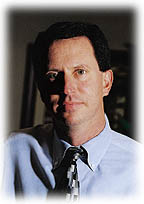
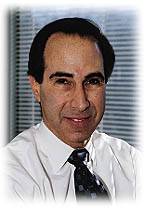 Blair left the Rothschild firm in 1985 and with a group of partners
founded Domain Associates, which has become one of the largest venture capital
firms specializing in life-science investments. Domain, whose main offices
are located on Palmer Square in Princeton, has invested over $350 million
in the past 15 years to create some 75 new life-science firms. Domain draws
its capital from institutional investors, principally university endowment
funds and corporate pension funds. Two of Blair's partners are Princeton
alumni-Jesse Treu *73 (left), who cofounded Domain with Blair after holding
research and development positions with General Electric and Technicon,
and Arthur Klausner '82 (right), previously the senior editor of the life-science
technical journal Bio/Technology Magazine.
Blair left the Rothschild firm in 1985 and with a group of partners
founded Domain Associates, which has become one of the largest venture capital
firms specializing in life-science investments. Domain, whose main offices
are located on Palmer Square in Princeton, has invested over $350 million
in the past 15 years to create some 75 new life-science firms. Domain draws
its capital from institutional investors, principally university endowment
funds and corporate pension funds. Two of Blair's partners are Princeton
alumni-Jesse Treu *73 (left), who cofounded Domain with Blair after holding
research and development positions with General Electric and Technicon,
and Arthur Klausner '82 (right), previously the senior editor of the life-science
technical journal Bio/Technology Magazine.
Domain Associates looks at close to a thousand proposals a year, and
selects about ten that it is willing to finance. In appraising potential
ventures, Blair and his colleagues look for three attributes. "We want
products that meet unmet medical needs," he says. "We want intellectual
property protection. And we want products that can lower the cost of delivering
medicine."
Evaluating the science
Blair, an electrical engineering major with advanced degrees in the field,
does not try to appraise the science involved in the proposals that cross
his desk. Instead he farms that out to scientists with expertise in the
field being addressed. Frequently his firm uses Princeton professors, but
it may also tap scientists at companies he has helped to launch. He restricts
his own inquiries to common- sense questions.
Typically there are two to five venture capital firms involved in the
deals Domain puts together, and it takes a while before they can begin to
reap their financial rewards, if ever. Will one of Domain's investments
become another Amgen? Blair and his partners certainly hope so. Among those
that are off to promising starts:
Trimeris, which is developing a new therapy for the treatment of AIDS.
Two products are currently in clinical trials.
Amlyn Pharmaceuticals, which has two products in clinical trials for
the treatment of Type I and Type II diabetes.
Aurora Biosciences, which manufactures large-scale systems to help pharmaceutical
companies automate the discovery of new drugs.
Cytovia, which develops novel anti-cancer drugs to treat tumors that
are resistant to traditional chemotherapies.
Chimeric Therapies, which is developing a new method of transplanting
bone marrow between unmatched donors and recipients.
Starting from scratch
At least a half-dozen Princeton alumni are involved in funding biotech
companies through venture capital companies.
Hal Werner '70 *71 founded HealthCare Ventures LLC in 1985, in conjunction
with three partners. HCV has invested in excess of $400 million in more
than 40 companies, most of which were started from scratch. Its biggest
successes to date include Medimmune, which manufactures and markets newly
developed antibodies and vaccines and which currently has a market capitalization
in excess of $9 billion. HealthCare also launched Human Genome Sciences,
the first company to commercialize genomic data. Human Genome has developed
a database of genetic materials that it and its pharmaceutical partners
are aggressively using to develop new compounds.
Shire Laboratories, a British company financed by HCV, has become one
of the world's fastest growing pharmaceutical companies. It focuses on the
prevention and treatment of osteoporosis and other metabolic bone disorders
and the treatment of central nervous system disorders such as attention
deficit disorder and Alzheimer's disease.
"Working in this field has been an extraordinary experience,"
says Werner. "Over the next 20 to 30 years biotechnology will affect
every aspect of society. It will greatly improve health and revolutionize
industrial processes and agriculture. There is no shortage of truly incredible
things we can do."
Late-stage ventures
 Operating out of his San Francisco office, John Diekman '65 (left)is
one of three managing partners of Bay City Capital, which has invested a
total of $350 million in 30 companies. A substantial amount of capital has
been provided by the Pritzker family, which amassed a fortune as the founders
of the Hyatt Hotel chain.
Operating out of his San Francisco office, John Diekman '65 (left)is
one of three managing partners of Bay City Capital, which has invested a
total of $350 million in 30 companies. A substantial amount of capital has
been provided by the Pritzker family, which amassed a fortune as the founders
of the Hyatt Hotel chain.
In general, Bay City Capital does not invest in brand-new companies,
preferring instead to put its chips on what Diekman calls "latter-stage
ventures." The cost of buying in at this point is almost invariably
higher, but the risk is lower since the science that underlies the venture
has at least been through preliminary tests and the firm's management has
a track record.
That's the practice, but not an inviolable rule. One of the more fascinating
companies funded by Diekman and his partners is Chemdex, basically an Internet
company that relates to the biotech and pharmaceutical industries. Chemdex
provides a unified catalog of chemicals sold by more than 1,000 suppliers.
By consulting Chemdex, researchers and other users of chemicals can identify
the companies that offer the best prices and relevant specifications, and
they can purchase these products online-sort of the Amazon.com of the chemical
industry. Chemdex, whose shares originally sold for $.70 apiece, recently
commanded a price of $98 a share and had a market capitalization of approximately
$3.3 billion.
 Aside from his Bay City investments, Diekman is a founding member of
the board of Affymetrix, one of the most promising companies in the biotech
industry. The company, whose chairman and CEO is Steve Fodor *85 (right),
pioneered the development of biochips, which permit researchers to acquire,
manipulate, and understand information derived from DNA samples. Using biochips,
researchers can, for instance, test cancerous tissues against a full battery
of genes and, relatively quickly, determine which genes are activated by
malignant tissues. With this information, the researchers might be able
to develop a substance that would prevent further growth of the cancer.
Aside from his Bay City investments, Diekman is a founding member of
the board of Affymetrix, one of the most promising companies in the biotech
industry. The company, whose chairman and CEO is Steve Fodor *85 (right),
pioneered the development of biochips, which permit researchers to acquire,
manipulate, and understand information derived from DNA samples. Using biochips,
researchers can, for instance, test cancerous tissues against a full battery
of genes and, relatively quickly, determine which genes are activated by
malignant tissues. With this information, the researchers might be able
to develop a substance that would prevent further growth of the cancer.
Biotech analysts believe that biochips are destined to become a $1 billion-a-year
industry. The demand is so strong that Affymetrix has recently built a new
DNA-chip factory in West Sacramento to deal with the surge of orders.
 Paul M. Wythes '55 (left), a Bay Area neighbor of Diekman and Fodor
and a Princeton trustee, is the founding general partner of Sutter Hill
Ventures. Since its founding in 1964, Sutter Hill has focused on early-stage
high-tech startups of all kinds. In the mid-1980s it began to move more
aggressively in the biotech field when it formed a limited partnership called
Biovest that funded six biotech ventures. Two of the six proved to be particularly
successful. Neurex, which was subsequently sold to Elan, the Irish pharmaceutical
corporation, developed Ziconotide, a painkiller used by terminally ill cancer
patients after morphine is no longer effective. BioSurface Technology, another
Biovest offspring, developed a product that tests for six different types
of substance abuse.
Paul M. Wythes '55 (left), a Bay Area neighbor of Diekman and Fodor
and a Princeton trustee, is the founding general partner of Sutter Hill
Ventures. Since its founding in 1964, Sutter Hill has focused on early-stage
high-tech startups of all kinds. In the mid-1980s it began to move more
aggressively in the biotech field when it formed a limited partnership called
Biovest that funded six biotech ventures. Two of the six proved to be particularly
successful. Neurex, which was subsequently sold to Elan, the Irish pharmaceutical
corporation, developed Ziconotide, a painkiller used by terminally ill cancer
patients after morphine is no longer effective. BioSurface Technology, another
Biovest offspring, developed a product that tests for six different types
of substance abuse.
Scientists are key
In the wake of Biovest's success, Sutter Hill has funded several other
biotech startups. The most notable of these was Hybritech, which developed
the PSA test that is now routinely used to screen for possible prostate
cancer. Ontogeny, another promising company funded by Sutter Hill, has developed
a skin culture system that allows the growth of complete skin without the
presence of blood serum. Its system is likely to be used by diabetes and
Parkinson's disease patients.
"The key to successful biotech investing is world-class scientists,"
says Wythes. "We aren't world-class scientists, but we spend a lot
of time checking people out."
Sutter Hill uses institutional capital exclusively, its investors being
Princeton, Yale, Stanford, MIT, Sun Life Assurance of Canada, the Irvine
Foundation, and the Power Corporation of Canada. Wythes estimates that Sutter
Hill's average annual rate of return over the past 30 years has exceeded
35 percent.
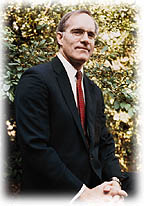 The lone ranger of the biotech-venture capital business is Bob Johnston
'58 (right), who presently has $20 million invested in seven ventures. Johnston
operates out of a large, converted clapboard house in Princeton just off
Route 206, using his own capital while simultaneously joint venturing with
other venture firms. Normally he launches the companies in which he is involved.
He left Smith Barney in 1967 to form Johnston Associates because he wanted
to work with smaller companies. Initially he financed mostly high-tech companies,
usually involved with computers, but in 1976 he entered the biotech field
when he founded Genex. The company was too broad-based, and Genex was eventually
sold.
The lone ranger of the biotech-venture capital business is Bob Johnston
'58 (right), who presently has $20 million invested in seven ventures. Johnston
operates out of a large, converted clapboard house in Princeton just off
Route 206, using his own capital while simultaneously joint venturing with
other venture firms. Normally he launches the companies in which he is involved.
He left Smith Barney in 1967 to form Johnston Associates because he wanted
to work with smaller companies. Initially he financed mostly high-tech companies,
usually involved with computers, but in 1976 he entered the biotech field
when he founded Genex. The company was too broad-based, and Genex was eventually
sold.
Johnston has since participated in the launching of several biotech firms.
The most notable of these is Sepracor, which has developed a way to purify
drugs, giving them additional potency and also effectively extending their
patent life, since the purified form is usually treated as a separate drug
by the FDA. Among the medicines Sepracor has developed in purified form
are Prozac, which is due to go off patent in 2003; Claritin, the anti-
allergy medicine, whose patents expire in 2002 and 2004; and Xopenex,
the substance used in an anti-asthma inhaler. Typically, Sepracor licenses
its purified drugs to the pharmaceutical companies that originally developed
them and retains a royalty arrangement with the company.
Success is uncertain
Johnston says that only about half the companies he launches succeed.
A variety of reasons are likely to account for the failures. The science
may not work. The concept may be overtaken by new breakthroughs. But most
often firms fail because of poor management, and this often relates to an
inability to communicate management's objectives within the firm. For this
reason Jim Blair, of Domain, spends about a third of his time on recruiting
and management issues.
It can take eight to 10 years before a new drug can win FDA approval.
Patience, says Blair, is the quality most critical to successful participation
in the biotech field.
The ability to endure slow processes is matched by more enticing rewards.
Venture capitalists speak glowingly of the excitement inherent in dealing
with very bright and creative people. Equally rewarding is the ability to
participate in the creation of products that are truly useful and that relieve
pain and suffering. "I'd rather do what I'm doing than anything else
in the world," says Blair.
Marvin Zim '57 is a freelance writer living in Washington, D.C.
Manufacturing people: what does
it mean to be human?
Looking at the issues raised by reprogenics
By Lee M. Silver
Advances in reproductive biology
In 1978, Louise Joy Brown became the first baby born from an embryo that
was created outside a human body. Today, there are hundreds of in vitro
fertilization (IVF) clinics around the world offering pregnancy success
rates of up to 70 percent. The birth of Louise Joy Brown represented a singular
moment in the history of humankind because it brought the human embryo out
of the darkness of the womb and into the light of the laboratory day.
There are two revolutionary implications of this ability to see and manipulate
human cells that could turn into human beings. The first concerns the manner
in which people are able to reproduce; the second concerns the power people
will have to select and alter the genes of the children they bear.
Advances in genetics
At the same time as reproductive horizons are expanding, there has been
an explosion in the area of genetic research and technology. The Human Genome
Project, with its goal of identifying every human gene, is only the first
step in this massive effort.
The second step is to identify all of the major ways in which people
differ at each of these genes, and how these genetic differences correlate
with differences in critical personal characteristics (like resistance or
susceptibility to known infectious and inherited diseases). It is only a
matter of time before connections are also made between genetic profiles
and physical or mental attributes that we commonly refer to as innate talents.
The new genetic technologies have implications for the practice of all
forms of medicine, but when they are combined with reproductive technologies,
the implications are staggering.
Reprogenetics
When reproductive and genetic technologies are combined, both their design
and purpose are so different from that of either technology alone that the
combination is deserving of a new appellation: reprogenetics. Reprogenetics
is defined as the use of genetic information or technology by an individual
in an attempt to ensure or prevent the inheritance of particular genes in
their child.
The technology already exists for parents to choose which of their own
genes to give children (through preimplantation genetic diagnosis or PGD).
But soon parents will be able to modify the genes in the embryos they produce
so that their children can be born with physical and physiological features
that they themselves do not express. This technological advance will be
the most important in the history of humankind because it could allow our
species to evolve into beings that are no longer human, as we understand
the meaning of the word today. This is the second implication of IVF.
Reprogenetics and
eugenics
Many bioethicists oppose all attempts by individual parents to control
the genes received by their children. They equate what I call reprogenetics
to the clearly abhorrent eugenic practices of the past. But reprogenetics
and eugenics are fundamentally different in terms of both control and purpose.
The stated purpose of eugenics was the improvement of the so-called gene
pool of a society by state control over the breeding practices of its citizens.
While eugenics is controlled at the level of a state, reprogenetics can
be controlled at the level of individual prospective parents. And while
eugenics is concerned with the vague notion of a societal gene pool, reprogenetics
is concerned with the very real, but narrow, question of what genes a single
child will receive.
Reprogenetics can be understood through its single motivating force:
the desire of prospective parents to give all possible advantages to their
children.
Embryo selection
There are two aspects of high technology reprogenetics dependent on the
use of IVF. The first is embryo selection and the second is germline genetic
engineering.
Embryo selection is based on the fact that DNA analysis can be performed
on a single cell removed from an eight-cell human embryo. (This protocol
is known as preimplantation genetic diagnosis or PGD.) PGD is now used when
two prospective parents are both carriers of a lethal disease gene like
cystic fibrosis. Sperm and eggs from the prospective parents are combined
by IVF to produce dozens of embryos, each of which is tested by PGD for
the presence or absence of the disease gene. Only embryos without the disease
gene are implanted into the woman's womb to initiate a pregnancy and birth
of a healthy child.
Incredibly, the technology of embryo selection is exactly the same no
matter what gene is analyzed. Thus, once the genes for height are characterized,
for example, parents could use PGD to select embryos that will develop into
taller children, or children with increased potential for longevity, or
increased potential for long-term happiness (which has a strong genetic
correlate). It is important to point out that, in every case, the embryo
selected could have been the one that implanted by chance in a natural pregnancy.
Embryo selection does not involve modification of the genome. It just allows
parents to select one microscopic embryo over another; it's equivalent to
placing the genetic dice on the table rather than throwing them for a random
outcome.
Human germline genetic engineering
Over the last 18 years, the technology of germline genetic engineering
has been used with increasing efficiency to alter the embryonic genomes
of a variety of mammalian species in an increasingly sophisticated manner.
Until recently, however, the possibility that this technology might be applied
to human embryos was not given serious consideration by most scientists.
There were three levels of technical problems that seemed insurmountable.
First, the technology was extremely inefficient, with success rates typically
less than 50 percent. Second, the application of the technology was associated
with a high risk of newly induced mutations. Finally, there was-and still
is-a general sense that genetic engineering can never be performed on people
because of the possibility that a particular modification might have unanticipated
negative side effects.
The technological landscape has changed drastically. With powerful new
genetic modification and screening technologies, it will soon become possible
to preselect only those genetically engineered embryos in which the desired
genetic change has been implemented without any damage to the preexisting
genome. This technical advance could eliminate the first and second problems
associated with genetic engineering. But what about the third problem? Even
if the embryo's genome is engineered exactly as intended, how can we be
sure of the impact it will have on the child that is born. In particular,
how can we rule out unintended, unanticipated, deleterious side effects?
Before we can answer this question, we must understand that while there
are a near-infinite number of genetic changes that can be made to an embryo,
they can all be placed into one of two broad categories which I have named
Type I and Type II. Type I genetic changes are those that will provide the
embryo with a gene that some other people get naturally. Type II genetic
changes are those that have not appeared previously within the human population.
Geneticists now understand that people are not born equal when it comes
to biological properties that include all physical and physiological characteristics
as well as disease resistance or susceptibility. For example, 1 percent
of all people carry a gene that provides absolute resistance to the HIV
virus that causes AIDS. Some people have superior cancer protection genes,
and others are born with genes that greatly increase longevity relative
to the average. The effects that these infrequent genes have on people can
be understood by studying many people who naturally carry those genes. Deleterious
side effects can be identified or ruled out before genetic engineering is
ever attempted with such "Type I genes."
Genetic enhancement with a Type I gene will allow parents to give their
child a gene that other children get naturally. Type I enhancement will
be feasible because the impact of the desired genetic change will have been
determined previously. In the near future, Type II genetic enhancements-those
not currently present in other human beings-will not be feasible because
of the possibility of unanticipated side effects.
The politics of type I genetic enhancement
For the sake of analysis, let us make the assumption that at some point
in the future, all technical problems associated with germline genetic engineering
are eliminated and it becomes possible to use the technology with a high
degree of safety and efficiency. Until such a time is reached, of course,
the use of genetic engineering would be considered unethical and unacceptable
by all. But if, and when, the technology is perfected for human use, we
must consider the ethics of its use in terms other than safety. I suggest
here that the ethical acceptability of Type I genetic enhancement will be
greatly influenced by the political foundation from which one is operating.
All modern democratic societies must balance the opposing political aims
of individual autonomy and social justice. In the U.S., individual autonomy
is of paramount importance. It is accepted that parents can spend their
own money to provide their children with advantages in health care, education,
and social status, although this puts children of less affluent parents
at a disadvantage. If a society allows parents to buy their children environmental
advantages, it has no logical basis for banning Type I genetic enhancements.
Americans would respond to any attempt at a ban with the question: "Why
can't I give my children genes that other children get naturally?"
In most western countries other than the U.S., social justice plays a
much larger role in politics and law. European countries try to achieve
social justice by providing equivalent health care and educational opportunities
to all children, irrespective of the affluence of their parents. From this
point of view, Type I genetic enhancements might seem immoral because they
are unfair to those children who did not receive them.
There is a biological flaw with the fairness argument: Children are not
biologically equivalent. Today, everyone is born naturally with advantages
or disadvantages across a range of health and physical characteristics as
well as innate abilities.
In the future, the critical question will be who decides how these advantages
and disadvantages are distributed? Should the decision be left to the randomness
of nature, as it is now? Should it be determined by the affluence of the
parents? Or should it be controlled by the state?
Who decides which child will get the HIV resistance gene, and which child
will have the potential for a long life span? There may come a time in the
future when by not making a decision, an individual or society actually
is making a decision in favor of randomness. In contrast, based on the desire
of a European-style social democracy to protect its citizens, it is possible
to argue that Type I genetic enhancement of basic physical and health characteristics
will become a positive responsibility of the state, just as childhood vaccination
is today (in Europe, although not the U.S.).
The provision and regulation of genetic enhancement technology will not
be easy. For unlike healthcare, there is no limit to how far you can go
with genetic enhancement. Furthermore, the desire to provide an advantage
for one's child is extremely powerful, and if one society bans or limits
the use of genetic enhancement, affluent citizens will be able to obtain
it elsewhere.
The future?
The use of genetic enhancement could greatly increase the gap between
"haves" and "have-nots" in the world. The gap may emerge
initially between classes within a society. But, if the cost of reprogenetic
technology follows the downward path taken by other advanced technologies,
it could become affordable to the majority members of the middle class in
western societies. Ultimately, Type II genetic enhancements-which provide
new non-human genes to children-will become feasible, and with Type II enhancements,
there really are no limitations to what is possible.
When this happens, the social advantage that wealthy societies currently
maintain could be converted into a genetic advantage. And the already wide
gap between wealthy and poor nations could widen further with each generation
until all common heritage is gone. A severed humanity could very well be
the ultimate legacy of unfettered global capitalism.
The only alternative is one that seems very remote today, and one that
may never be politically viable: a single world state in which all children
are provided with the same genetic enhancements and the same opportunities
for health, happiness, and success.
This was adapted from a talk given by Lee M. Silver, a professor of molecular
biology and of public affairs, called Reprogenetics: How Do a Scientist's
Own Ethical Deliberations Enter Into the Process. The paper is based on
topics discussed at greater length in Silver's book Remaking Eden: How Genetic
Engineering and Cloning Will Transform the American Family (Avon, 1998).
Harold Shapiro chairs bioethics
commission
In October 1995, President Clinton created the National Bioethics Advisory
Commission (NBAC) to "provide advice and make recommendations to the
National Science and Technology Council and to other appropriate government
entities" regarding two main matters. The first deals with the appropriateness
of departmental, agency, or other governmental programs, policies, assignments,
missions, guidelines, and regulations as they relate to bioethical issues
arising from research on human biology and behavior. And the second deals
with the application of that research.
President Shapiro chairs the commission, which consists of 18 nongovernment
professionals from around the country. The commission meets periodically,
and among its priorities, as listed on its Website, are: the protection
of the rights and welfare of human research subjects; and issues in the
management and use of genetic information, including, but not limited to,
human gene patenting.
The NBAC has four criteria in establishing other priorities: the public
health or public policy urgency of the bioethical issue; the relation of
the bioethical issue to the goals for federal investment in science and
technology; the absence of another entity able to deliberate appropriately
on the bioethical issue; and the extent of interest in the issue within
the federal government.
The commission's meetings are open to the public, and its reports are
available online. Its Website, www.bioethics.gov,
provides numerous links to other organizations and agencies that deal with
bioethical issues.
Defining our dna-human genome project
nears completion
Discovering how genes interact is next step
By Kathryn Federici Greenwood
With scientists around the world racing to completely describe the human
genetic blueprint, society stands on the edge of uncovering secrets of heredity
and a host of challenges and new possibilities. Two Princetonians, in particular,
are playing influential roles in this genetic revolution, Eric S. Lander
'78 and Shirley M. Tilghman.
Lander directs the Whitehead Institute/MIT Center for Genome Research,
one of the labs sequencing human DNA for the Human Genome Project (HGP),
"the most audacious endeavor undertaken in biology," according
to U.S. News & World Report. Begun in October 1990 and coordinated by
the Department of Energy and the National Institutes of Health, the project's
goal is to construct a complete catalog of all human genes, which collectively
make up the human genome. Privately funded research companies like Celera
Genomics are also sequencing the human genome in the hopes of harnessing
information that will lead to the development of new drugs or medical diagnostic
tests.
Genes are spaced along strands of DNA, which are tightly coiled within
chromosomes. The "code" for every gene is written using four chemical
compounds, or "letters," abbreviated as A, T, C, and G. Our genome
uses some 3 billion of these letters to spell out the estimated 100,000
genes carried within the nucleus of every human cell. Slight differences
in the sequence of letters determine different physical traits, such as
blue eyes or brown and the color of one's hair, as well as a person's odds
for developing certain genetically based diseases.
According to the Human Genome Project Information Website, as of February
1, 54 percent of the 3 billion DNA letters have been sequenced. By late
spring, the federal project expects to have a working draft of 90 percent
of the entire genome. Over the next three years, scientists will close the
remaining gaps in the sequence and improve its accuracy.
By pinpointing the location of genes and decoding their sequences, the
HGP provides researchers with tools to learn more about genetic diseases,
and in some cases how to prevent or cure them. Scientists have learned about
genes that indicate a predisposition for Alzheimer's, heart disease, diabetes,
and asthma. And they are also learning which genes are switched on in a
cancer cell. Lander is convinced that cancer will eventually be cured. He
told U.S. News: "The reason I do this work is so my kids' kids will
never die of cancer. And that is a pretty darn good goal."
Tilghman, the Howard A. Prior Professor in the Life Sciences, helped
shape the HGP. She served as a member of the 1988 National Research Council
committee that studied whether the federal government should consider a
large-scale project to sequence the human genome and wrote a framework for
starting the process. And most recently she has chaired a committee that
provides advice to Francis Collins, who directs the HGP from the National
Institutes of Health. As director of Princeton's new interdisciplinary Institute
for Integrative Genomics, she and other scientists at Princeton will pick
up where the HGP leaves off-identifying the functions of human genes and
then discovering how different genes act together in an integrated fashion.
The HGP "will radically change the practice of medicine," says
Tilghman. Scientists will develop much better diagnostic tools for diseases,
which could lead to better therapies. "In the future, individuals could
be given genetic report cards," Tilghman says, even as early as birth,
so they will know what diseases they are susceptible to and act accordingly.
The revolution in genetics raises a number of ethical, legal, and social
issues. If in the future each person's genome could be sequenced to determine
genetic risk for various diseases, should employers and insurers have access
to our genetic profiles? Will people with a predisposition to certain diseases
find it difficult to buy health insurance? Should genetic testing be performed
if there is no cure available? Will gene-based treatments for diseases be
affordable only to the rich? Will society eventually view individuals as
merely a collection of genes?
The HGP "will have extremely far-reaching effects on society,"
says Tilghman.
-Kathryn Federici Greenwood
For more on the Human Genome Project, go to http://www.ornl.gov/TechResources/Human_Genome/home.html.
GO TO
the Table of Contents of the current issue
GO TO
PAW's home page
paw@princeton.edu
 This feature provides a natural foothold for potential antibiotics.
A drug that could interfere with quorum sensing-making the bacteria "blind"
to autoinducer so they "think" they are in a dilute population
when, in fact, they are not-might delay or halt development of the disease.
With that realization, dozens of labs have started working on the problem
in the last five years. Bassler, who was content working on her glow-in-the-dark
bacteria, understood the implications. So did some of her colleagues in
the molecular biology department-especially those with experience dealing
with the biotechnology industry-and they urged her to patent her discovery.
In the fall of 1998, she disclosed her work to John Ritter (right), director
of Princeton's Office of Patents and Licensing.
This feature provides a natural foothold for potential antibiotics.
A drug that could interfere with quorum sensing-making the bacteria "blind"
to autoinducer so they "think" they are in a dilute population
when, in fact, they are not-might delay or halt development of the disease.
With that realization, dozens of labs have started working on the problem
in the last five years. Bassler, who was content working on her glow-in-the-dark
bacteria, understood the implications. So did some of her colleagues in
the molecular biology department-especially those with experience dealing
with the biotechnology industry-and they urged her to patent her discovery.
In the fall of 1998, she disclosed her work to John Ritter (right), director
of Princeton's Office of Patents and Licensing. That Christmas, an old friend and former colleague, Jeff Stein (left),
called to wish Bassler happy holidays and catch up on news. The pair had
worked in neighboring labs at the Agouron Institute before Bassler left
for Princeton and Stein joined a San Diego biotechnology company. Bassler
told him about her work with autoinducer 2.
That Christmas, an old friend and former colleague, Jeff Stein (left),
called to wish Bassler happy holidays and catch up on news. The pair had
worked in neighboring labs at the Agouron Institute before Bassler left
for Princeton and Stein joined a San Diego biotechnology company. Bassler
told him about her work with autoinducer 2. Many faculty and staff members in the Department of Molecular Biology
have ties to biotechnology and pharmaceutical companies. A few have licensed
their discoveries to industry. Elkins Professor Thomas Shenk (right), chairman
of the department, serves on several scientific advisory boards and is on
the board of directors of Novalon, a drug discovery firm whose CEO is one
of his former postdocs. Professor Jim Broach is director of research for
Cadus Pharmaceutical Corporation, which he helped found in 1992.
Many faculty and staff members in the Department of Molecular Biology
have ties to biotechnology and pharmaceutical companies. A few have licensed
their discoveries to industry. Elkins Professor Thomas Shenk (right), chairman
of the department, serves on several scientific advisory boards and is on
the board of directors of Novalon, a drug discovery firm whose CEO is one
of his former postdocs. Professor Jim Broach is director of research for
Cadus Pharmaceutical Corporation, which he helped found in 1992.
 The meeting that took place in late 1980 between Jim
Blair '61 (left) and George Rathmann *51 (pic at right) turned out to be
the beginning of something very big. Rathmann, who had previously headed
Abbott Labs' diagnostic research and development division, was seeking first-round
financing that would allow his newly formed company to develop proteins
that could stimulate the growth of red blood cells. Blair's company, a New
York-based affiliate of the Rothschilds, was seeking promising investments
in the health care field.
The meeting that took place in late 1980 between Jim
Blair '61 (left) and George Rathmann *51 (pic at right) turned out to be
the beginning of something very big. Rathmann, who had previously headed
Abbott Labs' diagnostic research and development division, was seeking first-round
financing that would allow his newly formed company to develop proteins
that could stimulate the growth of red blood cells. Blair's company, a New
York-based affiliate of the Rothschilds, was seeking promising investments
in the health care field.
 Blair left the Rothschild firm in 1985 and with a group of partners
founded Domain Associates, which has become one of the largest venture capital
firms specializing in life-science investments. Domain, whose main offices
are located on Palmer Square in Princeton, has invested over $350 million
in the past 15 years to create some 75 new life-science firms. Domain draws
its capital from institutional investors, principally university endowment
funds and corporate pension funds. Two of Blair's partners are Princeton
alumni-Jesse Treu *73 (left), who cofounded Domain with Blair after holding
research and development positions with General Electric and Technicon,
and Arthur Klausner '82 (right), previously the senior editor of the life-science
technical journal Bio/Technology Magazine.
Blair left the Rothschild firm in 1985 and with a group of partners
founded Domain Associates, which has become one of the largest venture capital
firms specializing in life-science investments. Domain, whose main offices
are located on Palmer Square in Princeton, has invested over $350 million
in the past 15 years to create some 75 new life-science firms. Domain draws
its capital from institutional investors, principally university endowment
funds and corporate pension funds. Two of Blair's partners are Princeton
alumni-Jesse Treu *73 (left), who cofounded Domain with Blair after holding
research and development positions with General Electric and Technicon,
and Arthur Klausner '82 (right), previously the senior editor of the life-science
technical journal Bio/Technology Magazine. Operating out of his San Francisco office, John Diekman '65 (left)is
one of three managing partners of Bay City Capital, which has invested a
total of $350 million in 30 companies. A substantial amount of capital has
been provided by the Pritzker family, which amassed a fortune as the founders
of the Hyatt Hotel chain.
Operating out of his San Francisco office, John Diekman '65 (left)is
one of three managing partners of Bay City Capital, which has invested a
total of $350 million in 30 companies. A substantial amount of capital has
been provided by the Pritzker family, which amassed a fortune as the founders
of the Hyatt Hotel chain. Aside from his Bay City investments, Diekman is a founding member of
the board of Affymetrix, one of the most promising companies in the biotech
industry. The company, whose chairman and CEO is Steve Fodor *85 (right),
pioneered the development of biochips, which permit researchers to acquire,
manipulate, and understand information derived from DNA samples. Using biochips,
researchers can, for instance, test cancerous tissues against a full battery
of genes and, relatively quickly, determine which genes are activated by
malignant tissues. With this information, the researchers might be able
to develop a substance that would prevent further growth of the cancer.
Aside from his Bay City investments, Diekman is a founding member of
the board of Affymetrix, one of the most promising companies in the biotech
industry. The company, whose chairman and CEO is Steve Fodor *85 (right),
pioneered the development of biochips, which permit researchers to acquire,
manipulate, and understand information derived from DNA samples. Using biochips,
researchers can, for instance, test cancerous tissues against a full battery
of genes and, relatively quickly, determine which genes are activated by
malignant tissues. With this information, the researchers might be able
to develop a substance that would prevent further growth of the cancer. Paul M. Wythes '55 (left), a Bay Area neighbor of Diekman and Fodor
and a Princeton trustee, is the founding general partner of Sutter Hill
Ventures. Since its founding in 1964, Sutter Hill has focused on early-stage
high-tech startups of all kinds. In the mid-1980s it began to move more
aggressively in the biotech field when it formed a limited partnership called
Biovest that funded six biotech ventures. Two of the six proved to be particularly
successful. Neurex, which was subsequently sold to Elan, the Irish pharmaceutical
corporation, developed Ziconotide, a painkiller used by terminally ill cancer
patients after morphine is no longer effective. BioSurface Technology, another
Biovest offspring, developed a product that tests for six different types
of substance abuse.
Paul M. Wythes '55 (left), a Bay Area neighbor of Diekman and Fodor
and a Princeton trustee, is the founding general partner of Sutter Hill
Ventures. Since its founding in 1964, Sutter Hill has focused on early-stage
high-tech startups of all kinds. In the mid-1980s it began to move more
aggressively in the biotech field when it formed a limited partnership called
Biovest that funded six biotech ventures. Two of the six proved to be particularly
successful. Neurex, which was subsequently sold to Elan, the Irish pharmaceutical
corporation, developed Ziconotide, a painkiller used by terminally ill cancer
patients after morphine is no longer effective. BioSurface Technology, another
Biovest offspring, developed a product that tests for six different types
of substance abuse. The lone ranger of the biotech-venture capital business is Bob Johnston
'58 (right), who presently has $20 million invested in seven ventures. Johnston
operates out of a large, converted clapboard house in Princeton just off
Route 206, using his own capital while simultaneously joint venturing with
other venture firms. Normally he launches the companies in which he is involved.
He left Smith Barney in 1967 to form Johnston Associates because he wanted
to work with smaller companies. Initially he financed mostly high-tech companies,
usually involved with computers, but in 1976 he entered the biotech field
when he founded Genex. The company was too broad-based, and Genex was eventually
sold.
The lone ranger of the biotech-venture capital business is Bob Johnston
'58 (right), who presently has $20 million invested in seven ventures. Johnston
operates out of a large, converted clapboard house in Princeton just off
Route 206, using his own capital while simultaneously joint venturing with
other venture firms. Normally he launches the companies in which he is involved.
He left Smith Barney in 1967 to form Johnston Associates because he wanted
to work with smaller companies. Initially he financed mostly high-tech companies,
usually involved with computers, but in 1976 he entered the biotech field
when he founded Genex. The company was too broad-based, and Genex was eventually
sold.